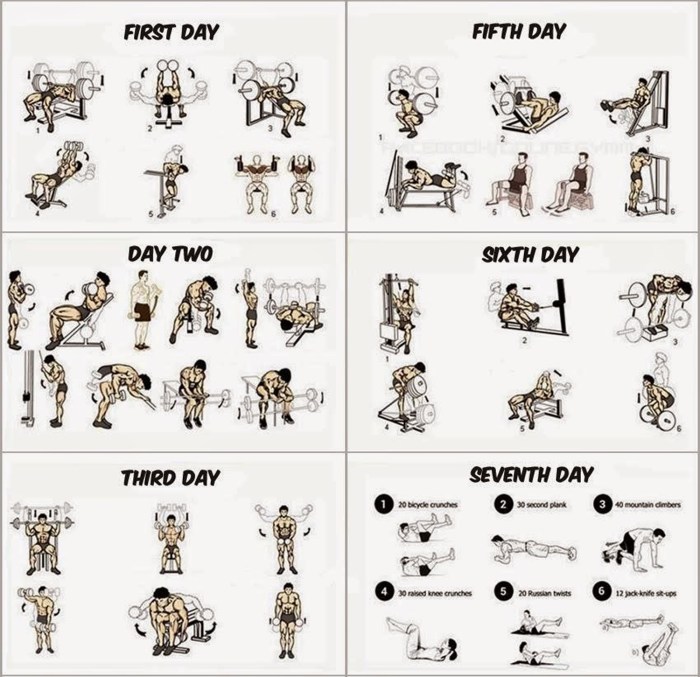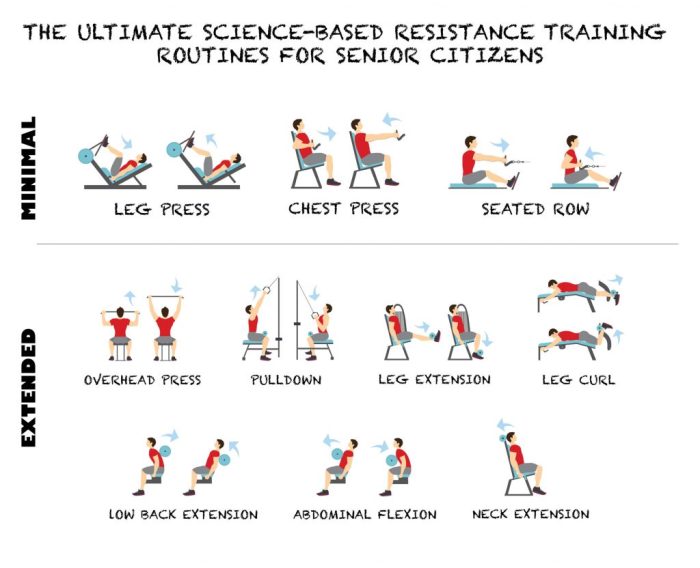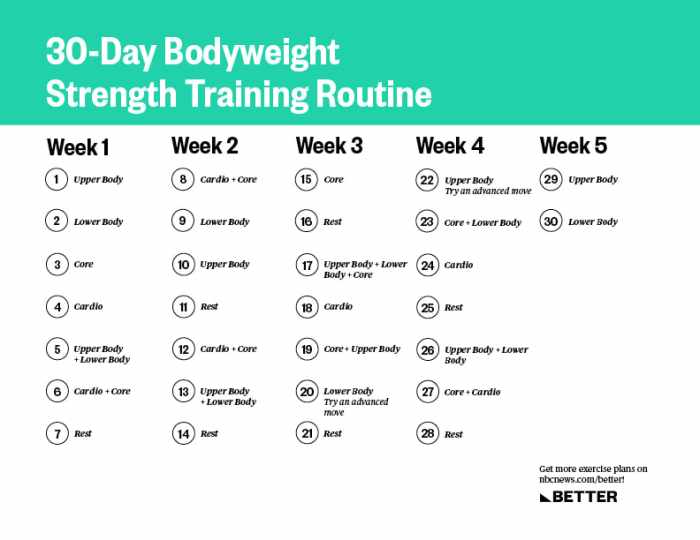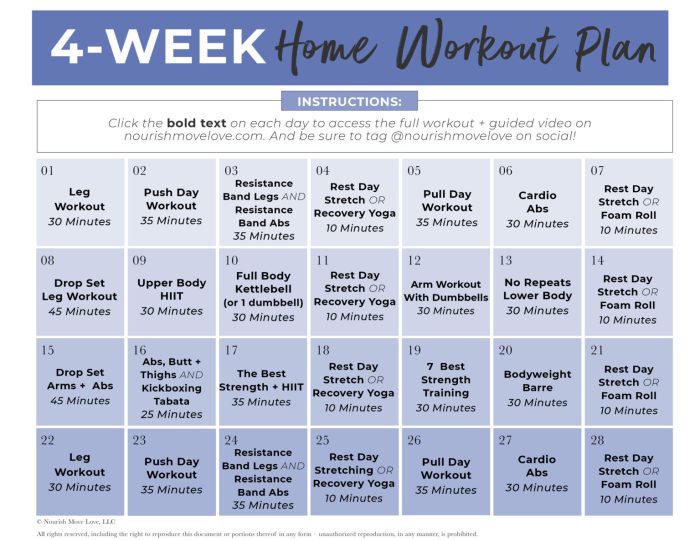Embark on a transformative journey with our strength building workout program, meticulously designed to ignite your physical potential. This comprehensive guide empowers you to sculpt a stronger, more defined physique, unlocking the gateway to improved health and well-being.
Through expert guidance and proven techniques, we’ll equip you with the knowledge and tools to maximize your strength building efforts, helping you achieve your fitness goals and unlock your true potential.
Introduction

Strength building is the process of increasing the force that your muscles can produce. It is an important part of overall fitness, as it can help you to perform everyday activities more easily, reduce your risk of injury, and improve your overall health.
A structured strength building program can help you to achieve your strength building goals safely and effectively. It will provide you with a plan that includes exercises that are designed to target all of the major muscle groups, as well as guidance on how to progress your training over time.
Benefits of a Structured Strength Building Program
- Increased strength
- Reduced risk of injury
- Improved balance and coordination
- Increased bone density
- Improved mood
- Better sleep
- Increased metabolism
Program Design

Effective strength training involves following specific principles that maximize results and minimize risks. Setting realistic goals and monitoring progress helps you stay accountable and track improvements. Periodization, or varying your training intensity and volume over time, is crucial for continued progress and avoiding plateaus.
Exercise Selection
Strength training exercises can be categorized into compound and isolation exercises. Compound exercises, like squats and bench presses, work multiple muscle groups simultaneously, while isolation exercises, like bicep curls and leg extensions, focus on a single muscle group. Incorporating both types of exercises into your program ensures balanced muscle development.
Weight and Repetitions
Choosing the appropriate weight and repetitions for your strength training exercises is essential. Beginners should start with a weight that allows them to maintain good form for 8-12 repetitions. As you progress, gradually increase the weight or repetitions to challenge your muscles and stimulate growth.
Rest and Recovery
Rest and recovery are vital for muscle repair and growth. Aim for 60-90 seconds of rest between sets and 2-3 minutes between exercises. Adequate sleep and nutrition also contribute to recovery and support your training efforts.
Benefits
Strength training offers numerous benefits beyond muscle growth. It improves bone density, reduces the risk of chronic diseases, enhances metabolism, and boosts overall health and well-being.
Motivation and Adherence
Staying motivated and adhering to a strength training program can be challenging. Set realistic goals, find an activity you enjoy, and track your progress to stay engaged. Consider working with a personal trainer or joining a gym community for support and accountability.
Nutrition
Nutrition plays a crucial role in supporting your strength training efforts. Consume adequate protein to repair and build muscle tissue, and include carbohydrates to fuel your workouts and replenish glycogen stores.
Warm-up and Cool-down
Warming up before and cooling down after your workouts prepares your body for exercise and aids in recovery. Dynamic stretching, light cardio, and foam rolling are effective warm-up methods. Post-workout, focus on static stretching to improve flexibility and reduce muscle soreness.
Common Mistakes
Avoid common mistakes like lifting too heavy too soon, neglecting form, overtraining, and ignoring rest and recovery. Prioritize proper technique, listen to your body, and consult with a qualified professional if needed.
Qualified Guidance
Consider working with a qualified personal trainer or coach to guide your strength training workouts. They can help you develop an individualized program, provide personalized instruction, and ensure you are training safely and effectively.
Exercise Selection
Choosing the right exercises is crucial for effective strength building. Target major muscle groups to ensure comprehensive development. Variety is key to avoid plateaus and engage different muscle fibers. Progression gradually increases resistance to challenge muscles and stimulate growth.
Major Muscle Groups
- Chest: Bench press, push-ups
- Back: Rows, pull-ups
- Shoulders: Overhead press, lateral raises
- Arms: Bicep curls, tricep extensions
- Legs: Squats, lunges, deadlifts
- Core: Planks, crunches
Exercise Variety
Vary exercises to target muscles from different angles and prevent imbalances. Include compound exercises (involving multiple joints) and isolation exercises (focusing on a single muscle group).
Exercise Progression
Gradually increase weight, sets, or repetitions to continually challenge muscles and promote growth. Listen to your body and rest when necessary to avoid injury.
– Discuss optimal training frequency for strength building
Optimal training frequency for strength building depends on individual factors, such as training experience, fitness level, and recovery capacity. Generally, beginners benefit from 2-3 strength training sessions per week, while experienced lifters may opt for 3-5 sessions.
Training frequency should allow for adequate recovery between sessions, as muscle growth and strength adaptations occur during rest. Excessive frequency can lead to overtraining and hinder progress.
Determining Training Intensity, Strength building workout program
Training intensity refers to the amount of weight or resistance used during exercises. Appropriate intensity stimulates muscle growth without causing excessive fatigue or injury.
Intensity can be measured as a percentage of one-repetition maximum (1RM), which is the maximum weight you can lift for a single repetition. For strength building, an intensity of 70-85% of 1RM is generally recommended.
Relationship between Training Frequency, Intensity, and Volume
| Training Frequency | Training Intensity | Training Volume |
|---|---|---|
| Low (2-3 sessions/week) | High (75-85% of 1RM) | Moderate |
| Moderate (3-4 sessions/week) | Moderate (70-80% of 1RM) | High |
| High (4-5 sessions/week) | Low (60-70% of 1RM) | Very High |
The table above illustrates the inverse relationship between training frequency and intensity. As frequency increases, intensity should decrease to maintain a manageable training volume.
Adjusting Training Frequency and Intensity Over Time
As you progress in your strength training journey, it’s essential to adjust training frequency and intensity to continue making gains. Gradually increase frequency or intensity as you become stronger and recover faster.
Monitor your progress and make adjustments based on your response to training. If you experience excessive fatigue or diminished strength, reduce frequency or intensity. Conversely, if you feel adequately recovered and progress has stalled, consider increasing these parameters.
Importance of Rest and Recovery
Rest and recovery are crucial for strength building. Adequate sleep, nutrition, and rest days allow for muscle repair, growth, and hormonal adaptations.
Aim for 7-9 hours of sleep per night, consume a balanced diet rich in protein, and incorporate rest days into your training schedule. Active recovery activities, such as light cardio or stretching, can aid in recovery without putting excessive stress on your body.
5 Proper Warm-Up Exercises for Strength Training
Before engaging in strength training, it’s crucial to prepare your body with warm-up exercises. These exercises help elevate your body temperature, increase blood flow to muscles, and enhance range of motion, reducing the risk of injuries and maximizing workout efficiency.
Exercises:
- Light cardio:Begin with 5-10 minutes of light cardio, such as jogging, cycling, or jumping jacks, to increase heart rate and warm up the muscles.
- Dynamic stretching:Perform dynamic stretches that mimic the movements you’ll be doing during your workout. Hold each stretch for 10-15 seconds, repeating 2-3 times.
- Bodyweight exercises:Include bodyweight exercises like squats, lunges, and push-ups to activate major muscle groups and improve coordination.
- Foam rolling:Use a foam roller to massage and release tension in muscles that will be worked during the workout.
- Joint mobility drills:Incorporate joint mobility drills to enhance range of motion and prepare joints for the exercises.
Nutrition and Recovery
Proper nutrition and adequate rest are crucial for successful strength building. Let’s explore their roles.
Nutrition
Nutrition provides the building blocks for muscle growth and repair. A balanced diet rich in protein, carbohydrates, and healthy fats is essential. Protein intake of 1.6-2.2 grams per kilogram of body weight is recommended for strength training.
Rest and Recovery
Rest is essential for muscle recovery and growth. Adequate sleep and rest days allow muscles to repair and rebuild, promoting strength gains. Active recovery activities like yoga or light cardio can enhance recovery while promoting blood flow.
Exercise Demonstrations

Mastering the proper form for each exercise is crucial for maximizing results and minimizing the risk of injury. To help you achieve this, we provide detailed step-by-step instructions, visual aids, and modifications for various fitness levels.
Step-by-Step Instructions
Each exercise demonstration includes clear and concise written cues that guide you through the movement. We describe the target muscle groups, proper form, and range of motion to ensure you execute each exercise effectively.
Visual Aids
To enhance your understanding, we incorporate visual aids such as images or videos. These provide a visual representation of the exercises, allowing you to see the correct form and movement patterns.
Modifications
We understand that everyone has different fitness levels and capabilities. That’s why we provide modifications for each exercise, categorized as beginner, intermediate, and advanced options. This allows you to tailor the workout to your current fitness level and gradually progress as you get stronger.
Table Format
To organize the exercise demonstrations, we use a table format. Each row represents an exercise and includes columns for exercise name, step-by-step instructions, modifications, and visual aids. This structure makes it easy to navigate and find the information you need quickly.
Clear and Concise Language
We strive to use simple and easy-to-understand language in our exercise demonstrations. Our goal is to ensure that you can follow the instructions without any confusion, allowing you to focus on performing the exercises correctly.
Sample Strength Building Workout Plan
This workout plan is designed to help you build strength and muscle mass. It includes a variety of exercises that target different muscle groups, and it incorporates varying intensities to help you progress over time.
Before starting any strength building workout plan, it is important to consult with a qualified personal trainer to ensure that the exercises are appropriate for your fitness level and goals.
Warm-up
- Light cardio for 5-10 minutes, such as jogging, cycling, or rowing
- Dynamic stretching for 5-10 minutes, such as arm circles, leg swings, and torso twists
Workout
| Exercise | Sets | Reps | Weight | Rest Time |
|---|---|---|---|---|
| Barbell Squat | 3 | 10-12 | 70% of 1RM | 2 minutes |
| Bench Press | 3 | 8-10 | 75% of 1RM | 2 minutes |
| Overhead Press | 3 | 6-8 | 80% of 1RM | 2 minutes |
| Barbell Row | 3 | 10-12 | 70% of 1RM | 2 minutes |
| Pull-up | 3 | 8-10 | Bodyweight | 2 minutes |
| Dumbbell Lunge | 3 | 10-12 per leg | 50% of 1RM | 2 minutes |
| Calf Raise | 3 | 15-20 | Bodyweight | 1 minute |
Cool-down
- Light cardio for 5-10 minutes, such as jogging, cycling, or rowing
- Static stretching for 5-10 minutes, such as holding each stretch for 30 seconds
Safety Considerations

Ensuring safety is crucial for an effective and injury-free strength-building journey. Maintaining proper form, listening to your body, and avoiding overtraining are essential.
Proper form and technique are vital to minimize the risk of injuries. Ensure you engage the correct muscles, maintain proper posture, and execute exercises with controlled movements. If unsure, consult a certified trainer for guidance.
Common Injuries and Prevention
| Injury | Prevention |
|---|---|
| Muscle strains | Warm up properly, use proper form, avoid overexertion |
| Joint pain | Maintain proper alignment, use appropriate weights, rest adequately |
| Back pain | Strengthen core muscles, maintain good posture, avoid lifting too heavy |
Safety Tips for Beginners
- Start gradually and progress slowly.
- Learn proper form before increasing weight or intensity.
- Listen to your body and rest when needed.
- Use a spotter for heavy lifts.
- Warm up before and cool down after workouts.
Avoid excessive weight or training too frequently, as this can lead to injuries. It’s essential to warm up and cool down before and after workouts to prepare your body for exercise and promote recovery.
Remember, safety is paramount. If you experience any pain or discomfort, stop the exercise and consult a medical professional or certified trainer.
Advanced Techniques
As you progress in your strength training journey, you may encounter plateaus or seek additional challenges. This is where advanced training techniques come into play. These methods can intensify your workouts and help you break through plateaus.
However, it’s important to note that advanced techniques should be used sparingly and only by experienced lifters. They can be demanding and increase the risk of injury if not performed correctly.
Supersets
Supersets involve performing two or more exercises back-to-back with little to no rest. This technique allows you to target multiple muscle groups simultaneously and increase the intensity of your workout.
For example, you could perform a set of squats followed immediately by a set of leg presses. This superset would work both the quadriceps and hamstrings.
Drop Sets
Drop sets involve performing multiple sets of an exercise with decreasing weight. This technique helps you overcome muscular fatigue and push your limits.
For example, you could start with a heavy weight for 8-10 repetitions. Once you reach failure, reduce the weight by 10-20% and continue for another 8-10 repetitions. Repeat this process until you can no longer perform any repetitions.
Forced Reps
Forced reps involve having a spotter assist you with the final few repetitions of an exercise when you reach muscular failure. This technique allows you to push beyond your limits and overload your muscles.
For example, if you’re performing a set of bench presses and reach failure at 10 repetitions, your spotter can assist you with the final 2-3 repetitions.
Benefits of Advanced Techniques:
- Increased muscle growth
- Improved strength gains
- Increased workout intensity
Risks of Advanced Techniques:
- Increased risk of injury
- Can be too demanding for beginners
- May lead to overtraining if used excessively
Motivation and Mindset: Strength Building Workout Program
Staying motivated throughout a strength building program is crucial for achieving your fitness goals. Motivation fuels your efforts, helps you overcome challenges, and keeps you focused on the path to success.
To maintain motivation, it’s essential to establish a clear goal and purpose for your workouts. Set realistic targets that align with your capabilities and provide a sense of accomplishment as you progress. Celebrate your milestones and acknowledge your achievements to reinforce your motivation.
Strategies for Staying Motivated
- Find an activity you enjoy:If you genuinely enjoy the exercises you’re doing, you’re more likely to stick with them.
- Set realistic goals:Don’t try to do too much too soon. Start with achievable goals and gradually increase the intensity and duration of your workouts as you get stronger.
- Find a workout buddy:Having someone to workout with can help you stay motivated and accountable.
- Listen to your body:Don’t push yourself too hard. If you’re feeling tired, take a rest day.
- Reward yourself:Give yourself small rewards for reaching your goals. This will help you stay motivated and make the process more enjoyable.
Overcoming Challenges
Everyone faces challenges when trying to build strength. The key is to not give up. When you encounter a setback, don’t get discouraged. Instead, learn from your mistakes and keep moving forward.
Here are some tips for overcoming challenges:
- Don’t compare yourself to others:Everyone is different, and everyone progresses at their own pace.
- Focus on your own progress:Track your workouts and see how you’re improving over time.
- Don’t be afraid to ask for help:If you’re struggling, talk to a personal trainer or other experienced lifter.
- Remember your why:Why did you start lifting weights in the first place? Keep your goals in mind when you’re feeling challenged.
Monitoring and Evaluation
Tracking your progress is essential for making adjustments to your strength building program and ensuring you’re on track to meet your goals.
Measuring Strength Gains
Quantitative metrics like weight lifted, repetitions completed, and sets performed can objectively measure your strength gains. Record these metrics in a training log or use a fitness tracker to track your progress over time.
Identifying Areas for Improvement
Qualitative feedback, such as perceived exertion and muscle soreness, can help you identify areas where you can improve. Use a scale of 1-10 to rate your perceived exertion during each set. Note any muscle soreness you experience after workouts, as it can indicate areas that need more attention.
Sample Progress Tracking Table
| Week | Weight Lifted | Repetitions Completed | Sets Performed | Perceived Exertion | Muscle Soreness ||—|—|—|—|—|—|| 1 | 100 lbs | 10 | 3 | Moderate | Mild || 2 | 110 lbs | 12 | 3 | Hard | Moderate || 3 | 120 lbs | 15 | 3 | Very hard | Severe |
Rest and Recovery
Rest and recovery are crucial for monitoring and evaluation. Monitoring your rest and recovery data can help you identify patterns and adjust your training program accordingly. For example, if you notice you’re consistently feeling overly fatigued or sore, you may need to increase your rest days or reduce the intensity of your workouts.
Variations and Specializations
Strength building programs come in various forms, each with its unique focus and benefits. Two prominent types are powerlifting and bodybuilding.
Powerlifting
Powerlifting prioritizes developing maximal strength in three lifts: squat, bench press, and deadlift. Training involves heavy weights and low repetitions, aimed at increasing overall strength and power. Powerlifting is beneficial for improving athletic performance and building a strong foundation for other strength-based activities.
However, it may not be suitable for those seeking muscle hypertrophy or aesthetic goals.
Bodybuilding
Bodybuilding emphasizes muscle growth and aesthetics. Training involves moderate weights and higher repetitions, targeting specific muscle groups to enhance their size and definition. Bodybuilding is effective for developing a muscular physique and improving overall body composition. However, it may not be as effective for developing maximal strength as powerlifting.The choice between powerlifting and bodybuilding depends on individual goals and preferences.
For those seeking overall strength and power, powerlifting is a suitable option. For those prioritizing muscle growth and aesthetics, bodybuilding is a more appropriate choice.
Equipment and Resources

Strength training can be done with minimal equipment, but having the right gear can make your workouts more effective and comfortable.
Essential Equipment
* Barbell: A long, straight bar used for exercises like squats, deadlifts, and bench press.
Dumbbells
Weighted handheld bars that come in various sizes and shapes.
Kettlebells
Ball-shaped weights with a handle, used for swings, snatches, and other dynamic exercises.
Resistance bands
Elastic bands that provide resistance for exercises like bicep curls and tricep extensions.
Weight bench
A padded bench used for exercises like bench press and dumbbell rows.
Power rack
A sturdy frame that holds a barbell, allowing for safe and controlled lifting.
Accessories
In addition to essential equipment, there are accessories that can enhance your workouts:* Weightlifting belt: Supports the lower back and core, reducing the risk of injury during heavy lifts.
Wrist wraps
Stabilize the wrists during exercises like overhead press and barbell rows.
Lifting shoes
Designed with a raised heel to improve stability and power during squats and deadlifts.Using accessories can improve your form, increase safety, and allow you to lift heavier weights.
– Address common questions related to strength building, such as
Strength building is a journey that requires dedication, consistency, and proper knowledge. Here are some frequently asked questions (FAQs) to help you navigate this journey effectively:
| Question | Answer |
|---|---|
| How often should I train? | For optimal strength gains, aim for 2-3 strength training sessions per week, with at least 48 hours of rest between sessions. |
| How much weight should I lift? | Start with a weight that is challenging but allows you to maintain good form. Gradually increase the weight as you progress. |
| What is the best way to progress? | Incorporate progressive overload by gradually increasing the weight, sets, reps, or training frequency over time. |
| How do I avoid injury? | Use proper form, warm up thoroughly, and listen to your body. If you experience any pain, stop the exercise and consult a medical professional. |
| What are the best exercises for building strength? | Compound exercises like squats, deadlifts, bench press, and overhead press are excellent for overall strength development. |
| How do I know if I’m making progress? | Track your workouts, monitor your strength gains, and observe changes in your body composition. |
| What are some common mistakes to avoid? | Lifting too heavy, neglecting proper form, training too frequently, and ignoring rest and recovery. |
| How do I stay motivated? | Set realistic goals, find a training partner, and celebrate your achievements. |
| What are the best resources for learning more about strength building? | Books, articles, online forums, and certified personal trainers can provide valuable information. |
| What are the benefits of strength building? | Increased strength, improved body composition, reduced risk of injury, and enhanced overall fitness. |
If you have any other questions, please feel free to contact us.
Conclusion

As you progress through this program, you’ll not only witness remarkable physical transformations but also experience a profound boost in confidence and self-esteem. Embrace the challenge, push your limits, and emerge as a stronger, more capable version of yourself.
Remember, consistency and dedication are the cornerstones of success. Stay committed to your training, fuel your body with nutritious foods, and allow for adequate rest and recovery. By following these principles, you’ll unlock the full potential of our strength building workout program and achieve your fitness aspirations.
General Inquiries
How often should I train?
For optimal results, aim for 2-3 strength training sessions per week, allowing for adequate rest and recovery between workouts.
How much weight should I lift?
Start with a weight that challenges you while maintaining good form. Gradually increase the weight as you progress and become stronger.
What is the best way to progress?
Incorporate progressive overload by gradually increasing the weight, sets, or reps over time to continuously challenge your muscles and promote growth.
How do I avoid injury?
Always prioritize proper form and technique. Listen to your body and avoid overtraining. Warm up before workouts and cool down afterward to minimize the risk of injuries.
What are the best exercises for building strength?
Compound exercises that target multiple muscle groups, such as squats, deadlifts, bench press, and overhead press, are highly effective for building overall strength.
How do I know if I’m making progress?
Track your progress by monitoring your strength gains, such as the amount of weight you can lift, the number of reps you can complete, and the sets you can perform.
What are some common mistakes to avoid?
Avoid lifting too heavy too soon, neglecting proper form, overtraining, and inadequate nutrition.
How do I stay motivated?
Set realistic goals, find a workout buddy, track your progress, and reward yourself for your effort.
What are the best resources for learning more about strength building?
Consult with a certified personal trainer, read reputable fitness publications, and explore online resources dedicated to strength training.
What are the benefits of strength building?
Strength building offers numerous benefits, including improved physical performance, increased muscle mass, enhanced bone density, reduced risk of chronic diseases, and boosted confidence.
Leave a Reply